Artillery missile defense: a new proposal of American specialists
The other day, their views on the existing problem were described by the Office of Strategic Opportunities Department of the US Department of Defense. The specialists of this organization see all the actual problems of existing missile defense systems and are looking for ways out of this situation. From the emerging crisis of cost, quality and efficiency, it is proposed to emerge due to a non-standard approach to the defeat of the enemy’s incoming missiles. Instead of the "traditional" antimissile it is now proposed to use special artillery shells.
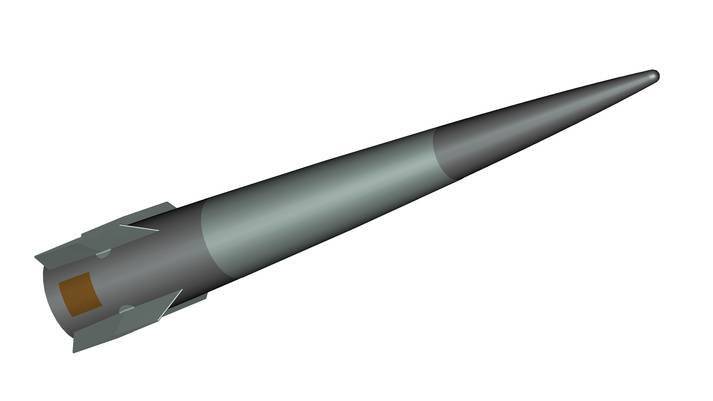
General view of the HVP projectile. Figure BAE Systems / baesystems.com
A press conference was held a few days ago with the participation of Vincent Sabio, manager of the Office of Strategic Opportunities, who oversees the development of a promising HVP artillery projectile (Hyper Velocity Projectile - “Hyper Speed Projectile”). Currently, the fate of this project remains in question, and therefore scientists and designers are forced to look for new applications for a projectile with an uncertain future. The new proposal, announced by V. Sabio, implies the use of the HVP product in the missile defense system.
According to the HVP project manager, existing missile defense systems based on interceptor missiles have certain problems. First of all, they are very complex and expensive. So, the Patriot anti-aircraft missile complex, capable of shooting down enemy tactical missiles, costs about 3 million dollars. The cost of other anti-missile systems, including those designed to deal with more serious threats, is even higher. The price affects the rate of production and supply of serial products, and, consequently, the effectiveness of the entire missile defense system as a whole.
The Patriot, THAAD or GBI complexes also have another characteristic problem. Their main elements are large in size and therefore can be detected by the enemy. Considering the number of launchers and antimissiles on them, the enemy will be able to plan an effective strike that can penetrate the existing "shield". Moreover, some anti-missile systems are forced to fire several anti-missile missiles at the same target at once, which is why the defense breakthrough will happen a bit earlier.
Thus, as noted by V. Sabio, a truly effective defense system should use relatively cheap means of destruction, characterized by sufficient technical and combat characteristics. The Office of Strategic Opportunities analyzed the current state of missile defense and proposed a new option for the destruction of incoming missiles. It is proposed to attack them with the use of traditional-style artillery shells and special shells. This concept has already been analyzed and even reached the preliminary design work. In the near future we plan to get the first real results.
The proposed concept makes it possible to significantly simplify the deployment of anti-missile systems and get other benefits. An HVP projectile, adapted to combat ballistic missiles, can be used with various 155 mm ground guns in towed or self-propelled performance. Due to this, the missile defense area can be deployed in the shortest possible time and at minimal cost. In addition, we should not forget about the resulting masking: unlike air defense missile systems or missile defense systems, guns or self-propelled guns in positions can not be clearly identified as a means to protect against missiles. Warships equipped with 127-mm artillery mounts will be another "carrier" of anti-missile missiles.
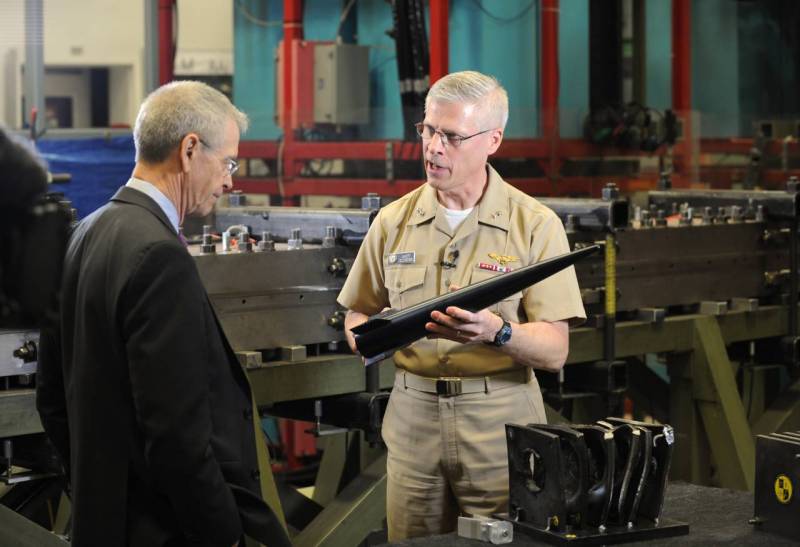
Rear Admiral Matthew Klander (right) shows the HVP product to CBS correspondent David Martin, 4 on April 2014. Photo by US Navy
For the destruction of enemy missiles are invited to use a promising projectile HVP, developed by BAE Systems for the Pentagon. Initially, this ammunition was created in the interests of the US naval forces and was to be included in the ammunition of the new naval artillery installations; The project started in 2012. The 127 mm caliber product was also planned to be supplemented with a dumping pallet, with which it could be used with ground 155-mm artillery.
According to published data, the HVP product gets a conical case with X-shaped rudders in the tail section. A characteristic feature of the hull is high strength, corresponding to aerodynamic and thermal loads during flight with a design speed. The total length of the projectile is 24 inches (609,6 mm). Weight - 28 pounds (12,7 kg). The product may carry a warhead weighing 15 pounds (6,8 kg). First of all, the creation of a high-explosive fragmentation version was envisaged, but in the future it was not excluded the use of other payload options.
HVP projectile was intended for guns with fundamentally different ways of acceleration. It could be used with traditional artillery systems using a propellant powder. Means were also created to ensure compatibility with advanced rail cannons. According to open data, the differences between the two HVP artillery shots for different guns, first of all, consisted in the presence of a sheath with a propelling charge and in the design of the dumping pan.
Previously, the company-developer of the HVP project indicated that the acceleration of the projectile using a powder charge in the barrel of a traditional design allows to obtain an initial velocity of the order of M = 3. Launching the “Hyper Speed Projectile” from a rail gun allows this parameter to be at least doubled. Flight speed, 6-7 times the speed of sound, should have led to a serious increase in firing range and power of ammunition. Saving a significant part of the kinetic energy, the projectile could inflict damage even without using a warhead.
The development of the HVP projectile was completed in 2015, and soon BAE Systems, together with the customer, began testing. In the same year, the first shooting took place using a new ammunition. In the future, such products were repeatedly sent into the flight from the barrels of ship and land guns. Test firing was also carried out using an experienced rail gun.
A new proposal by the Office of Future Opportunities is the use of HVP anti-ballistic missiles and shells. To solve new problems, the existing projectile will have to be refined in a certain way. So, he will need a new fuse with a programmable disruption. The combat unit can be converted to perform new tasks.
It may be necessary to refine the weapons that will have to launch anti-missile missiles. First of all, they need new fire control devices capable of taking target designation and calculating the correct corrections for a shot. In the case of ship artillery, such improvements will be as simple as possible. In fact, it will only be necessary to change the software of the onboard information management systems, “having taught” him to count not only an anti-missile attack, but also firing unguided projectiles.
According to the calculations of Pentagon specialists, ship cannons can be used in a new role without any noticeable improvements to the main details. They are distinguished by a large barrel length and are able to ensure the correct acceleration of the projectile to the required speeds. The shorter ground bore 155-mm howitzers, in turn, may require upgrading. Guns will have to get new barrels, improved muzzle brakes and recoil devices, etc. However, in this case the project of anti-missile artillery will be noticeably cheaper than the “traditional” missile defense system.
An important feature of the proposed concept, constantly mentioned by Vincent Sabio, is the low cost of production and operation. Artillery complexes of various kinds themselves are much simpler and cheaper than anti-aircraft missile systems or specialized missile defense systems. In addition, more cheap and different ammunition for them.
In accordance with the original terms of reference, the future Hyper Velocity Projectile projectile was supposed to cost about 25 thousand dollars. The designers did not manage to meet this framework, and the real ammunition turned out to be several times more expensive. At the moment, one HVP product costs about 85 thousands - almost three and a half times more than the customer wanted. Due to the constant increase in cost, the HVP program has long been criticized, even to the point of closing down.
However, in the context of missile defense such a high cost of the projectile may not be considered critical. V. Sabio rightly noted that instead of a single rocket for the Patriot air defense system, the army can buy about HNP 35 shells. Thus, intercepting a flying ballistic target will be less expensive. In addition, the calculation of the missile defense system will have the right to slip, not leading to overspending of ammunition, excessive spending or disrupting the interception.
In general, the Office of Strategic Opportunities considers the new proposal on the use of non-standard anti-missile defense systems interesting and, at least, worth considering and elaborating. For the full implementation of such plans you will need to carry out a certain amount of research and development work. First of all, it is necessary to create a detection and control system capable of controlling the operation of artillery systems. You may also need some kind of refinement tools proposed for use. Finally, a certain alteration of the existing “Hyper-velocity projectile” is possible.
The original concept has already passed the preliminary proposal stage and has already been accepted into the work. Soon it is planned to launch full-fledged design work and even carry out tests of the new complex. Until the end of 2018, the Strategic Opportunities Office plans to prepare the necessary means, and then conduct the first practical tests of the existing HVP artillery and HVP projectile as part of the missile defense.
Studying the new idea of the Office of Strategic Opportunities, one can notice that the proposed concept has several weak points. Depending on further developments, they can impede the work of engineers or even put an end to the project. If decision makers consider these problems critical, the concept will go to the archives, and the US Army will not receive artillery missile defense.
The concept of a new missile defense system based on the barrel or rail artillery and the HVP projectile has both advantages and disadvantages. The positive qualities of such a system in a recent speech listed Vincent Sabio. The representative of the Pentagon tactfully kept silent about the problems and shortcomings. However, this does not prevent to consider and study the concept independently.
Perhaps the main problem of the proposed missile defense system is the highest requirements for an HVP projectile to the gun. This product can show high flight and combat qualities only when launched from a rail cannon. Smaller indicators of energy powder systems simply will not allow him to realize their full potential. In addition, a lower initial speed will reduce the target's reach in range and altitude. Lengthening the barrels of existing guns will give a certain increase in characteristics, but it will not be decisive.
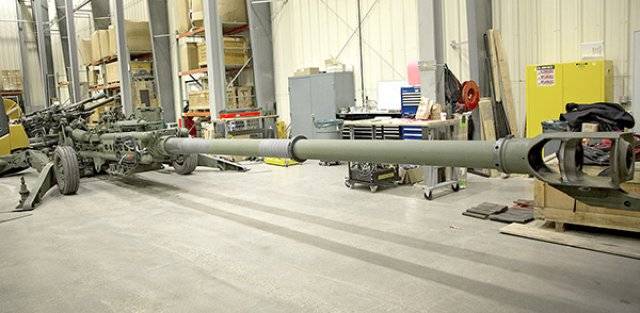
ERCA 155-mm howitzer, featuring an elongated barrel. Photo Breakingdefense.com
The use of rail guns can actually be forgotten. The American industry has achieved certain results in this area, but not so long ago, the most interesting project of the ship's guns was transferred to the category of research. Because of this, the existing and promising ships will continue to be equipped with artillery of traditional appearance. However, the appearance of a serial rail gun would still reduce the real advantages of the new missile defense system. Such a tool is extremely expensive, and extra costs could “eat” a substantial part of the savings on ammunition.
The use of powder artillery reduces the possible initial velocity of the projectile Hyper Velocity Projectile, and at the same time reduces the firing range. A small combat radius in combination with the speed of the fall of the enemy’s missile or its combat unit will lead to a sharp reduction in the permissible reaction time. Among other things, this will exclude the possibility of firing at warheads of relatively long-range missiles falling at too high a speed. They still have to intercept their interception on the usual anti-missiles.
A short time allowed to respond to a threat could adversely affect the effectiveness of a fire. The weapons involved in the missile defense system will indeed be able to make several shots at the target, and this will be cheaper than launching one anti-missile. But, at the same time, any miss of gunners can be critical for the object being protected.
Finally, for the construction and deployment of original missile defense systems, organized with the use of existing weapons, new specialized means of detection, communication and control are needed. To create them will take some time and appropriate funding. How such spending will affect the savings obtained from ammunition - we can only guess.
From a certain point of view, the new proposal of the Office of Strategic Studies may look like an attempt to find a real use for the Hyper Velocity Projectile, which has lost some of its prospects due to the rejection of combat rail cannons. At the same time, the concept is of some interest and may even find application in practice. To determine the real prospects of the proposed project, it is necessary to carry out some design work, and then organize tests, during which shooting at a ballistic target will be simulated.
At the moment, the project of artillery missile defense based on the HVP projectile is in its early stages. During this year, the Pentagon plans to conduct the first tests that will reveal the real potential of the proposed concept. It has positive and negative features, and therefore further events are difficult to predict. Whether it will be possible to implement the existing plans and make the existing projectile a promising antimissile means will be known later. While an unusual project is interesting only in terms of technology. The practical benefits of it are still unknown.
On the materials of the sites:
https://breakingdefense.com/
http://warspot.ru/
https://news.usni.org/
http://nextbigfuture.com/
http://globalsecurity.org/
http://navweaps.com/
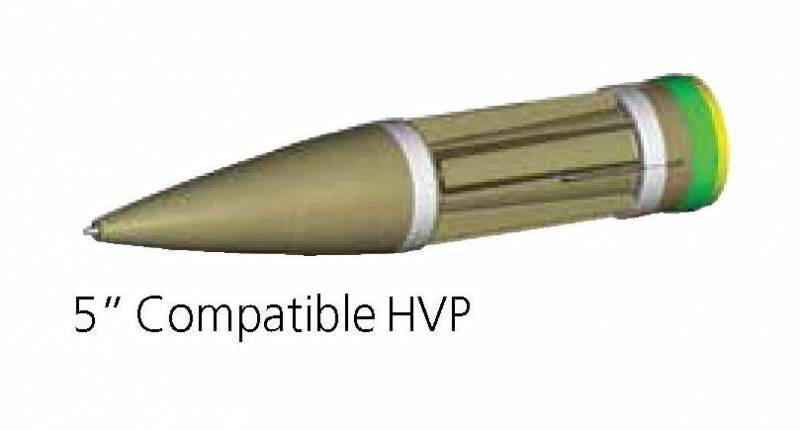
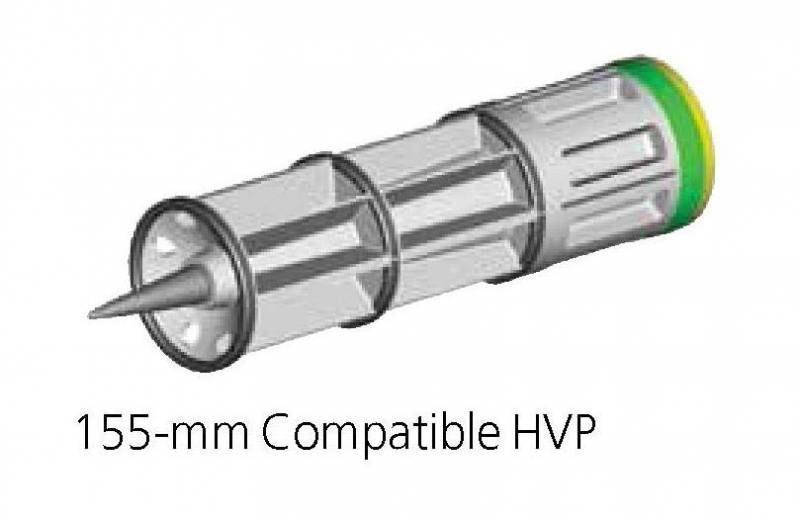
Information